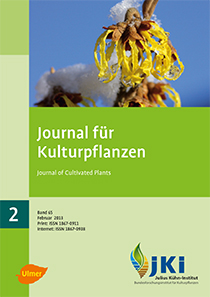Investigation of brown asparagus spears with specific consideration of <em>Fusarium</em> and virus infections in asparagus plantations of Saxony-Anhalt
DOI:
https://doi.org/10.5073/JfK.2013.02.02Keywords:
Asparagus officinalis, Fusarium spp., Virus diseases, AV-1, AV-2, CMV, ArMV, TSV, ELISAAbstract
Asparagus producers report about increasing asparagus browning of spears in the field. The reason is unknown. Contrary, a general strong infestation of asparagus with Fusarium spp. and viruses, especially the Asparagus virus 1 (AV-1) is known. The recent study was carried out to investigate the status quo of asparagus browning, infestation with Fusarium spp. and viruses within asparagus plantation in Saxony-Anhalt.
A total of 429 spears obtained from 14 companies, 27 plantations and 7 asparagus cultivars were investigated. 60.4% of spears have been shown symptoms of browning and 28.4% Fusarium spp. after in vitro incubation. In 92.8% of spears AV-1 was observed via ELISA, in 31.9% the Asparagus virus 2 (AV-2) and in 84.6% the Cucumber mosaic virus CMV. The Arabis mosaic virus (ArMV) was detected in 3.5% of spears only, the Tobacco streak virus (TSV) in none of spears. Merely 2 spears (0.5%) were free of virus. Differences in the level of infestation were observed between the plantations but not between cultivars. Possible relations between the different diseases investigated are discussed.
Downloads
Published
Issue
Section
License
The content of the journal is licensed under the Creative Commons Attribution 4.0 License. Any user is free to share and adapt (remix, transform, build upon) the content as long as the original publication is attributed (authors, title, year, journal, issue, pages).
The copyright of the published work remains with the authors. The authors grant the Journal of Cultivated Plants, the Julius Kühn-Institut and the OpenAgrar repository the non-exclusive right to distribute and exploit the work.







